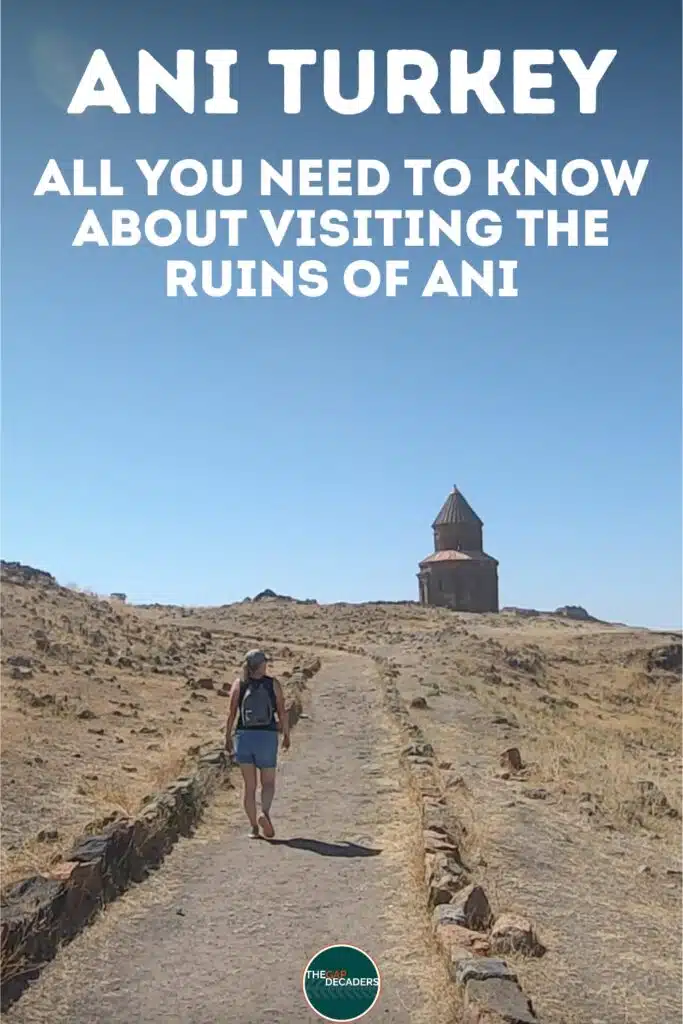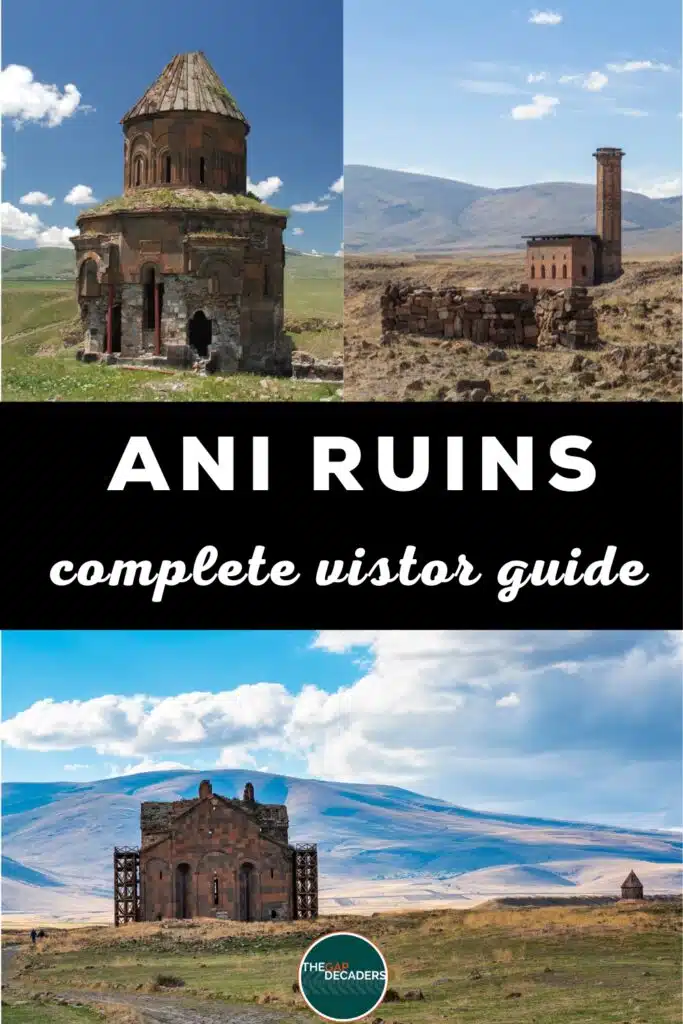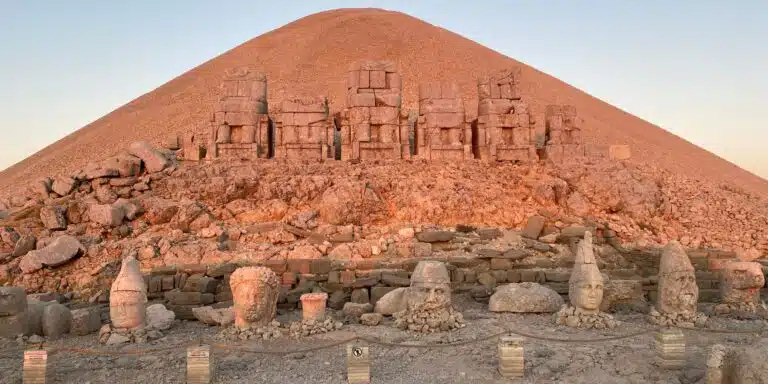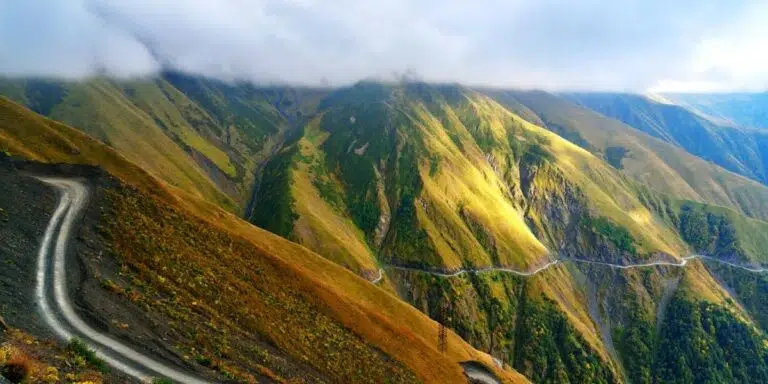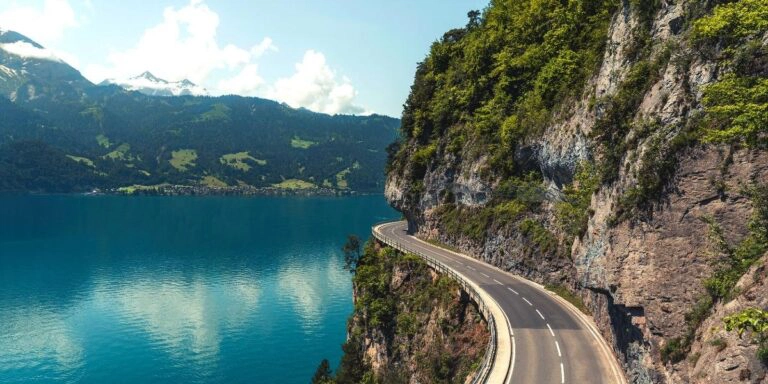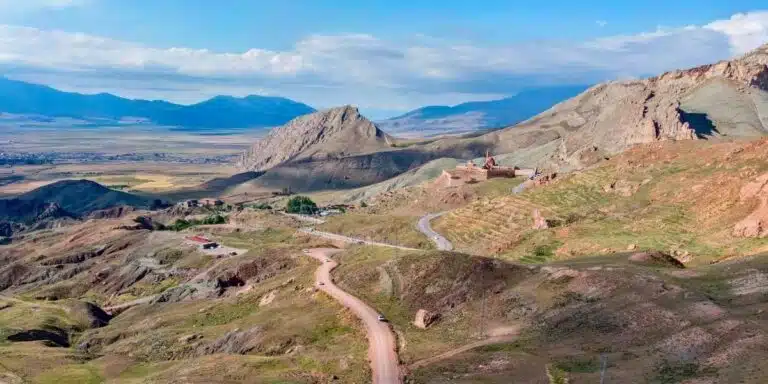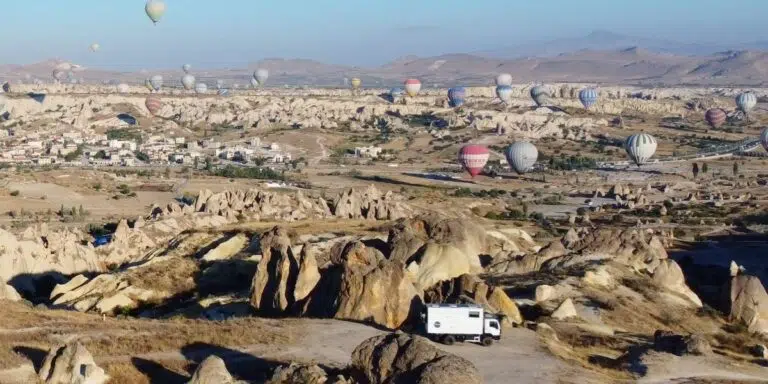This post may contain affiliate links, from which we earn an income. Click here to read our affiliate policy.
Ani is an unforgettable and hauntingly evocative place in off-the-beaten-path Turkey, whose arid and dusty slopes were once the Armenian capital and a thriving stop on the Silk Road.
About 45km east of the city of Kars, Ani is known as the ‘city of 1001 churches and 40 gates’ and is a must-see if you’re visiting the region, even if you’re not a history buff. The huge scale of the ruined city atop a sun-baked plateau overlooking the Armenian border, with vast hulks of buildings punctuating the skyline, is stunning.
In this guide to Ani, you’ll find everything you need to know about visiting the UNESCO World Heritage List archaeological site of Ani, and how to make the most of your trip there.
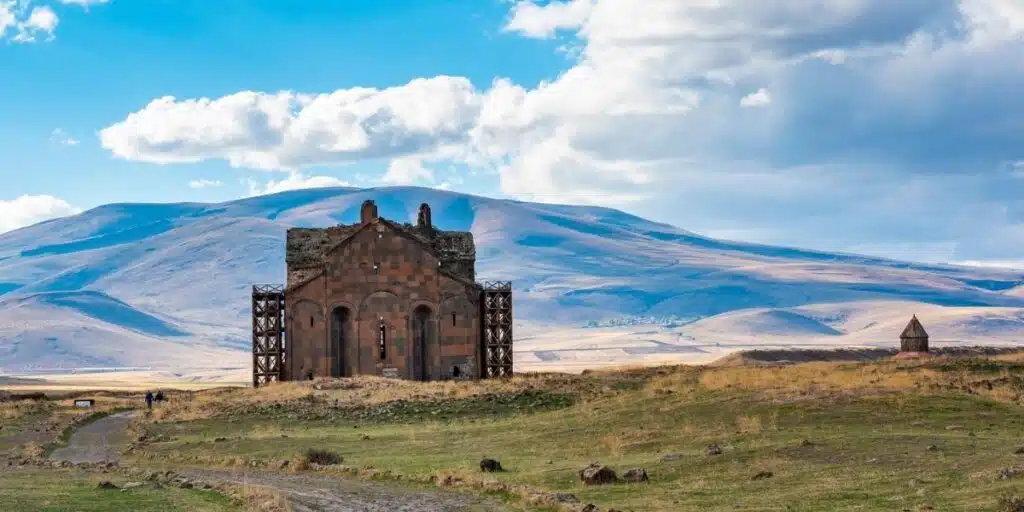
Location of Ani
The medieval city of Ani is located to the far northeast of Turkey’s Eastern Anatolia region. In fact, Ani is so far east it’s right on the Turkish-Armenian border, with just the Akhurian River separating the two countries.
Until a few years ago the whole area was a militarized zone and Ani, one of Turkey’s nineteen UNESCO World Heritage Sites, was out of bounds. As relations have thawed between Turkey and Armenia, Ani has shed its ‘ghost city’ label and is now a destination accessible to all travelers.
If you take a wider tour of the region and learn Armenian, you’ll soon learn about the strength of feeling between the two countries and the bloody history they share.
Map of Ani & Kars
Ani is not always shown on maps, maybe because it’s no longer classed as a city or because it used to be a military area. To find Ani, search for the village of Ocakli or Ani harabeleri, which means ruins.
How to use this map – Use your fingers (or computer mouse) to zoom in and out. Click or touch the icons to get more info about a place, and click the arrow in the box top left to open the index. To add to your own Google Maps account, click the star next to the title of the map.
How to Get to Ani
Independent Travel
Driving to Ani
Kars and Ani are easily reached by car, with a road trip from Ankara taking around fourteen hours. You’ll want to find some other Turkish road trip attractions on the way or around Ani and Kars, to make the trip worthwhile.
Flying to Ani
Nearby Kars has an airport with several daily direct flights from Istanbul with Turkish Airlines and Pegasus Air. It takes around two hours to fly to Kars, and it is just about possible to do a return trip by plane in a day, but you would need to have a taxi collect you from the airport and take you directly to Ani and back again. It would be far better to spend a night in Kars and have more time to explore.
Taking the Train to Ani
The wonderful overnight Dogu (Eastern) Express train travels daily between Ankara, Kayseri (for Cappadocia) and Kars, departing at 17.55pm daily and arriving at 8am – this is the way I would travel to Kars if I wasn’t driving.
Getting Around in Kars & Ani
Once in Kars, it’s easy to hire a car for the final 40-minute drive to Ani. The road to Ani is in good condition and the landscape consists of vast open grasslands. Beautiful year round, this drive is especially interesting during harvest when you can see traditional farming methods at work as the fields give up their summer bounty.
Alternatively, you can haggle over the price of a taxi from Kars, ask your hotel to arrange a driver or catch the tourist dolmus bus which leaves from outside Mix Point Kafe at 10am daily, waits for two hours in Ani, and then returns to Kars.
On arrival at Ani, you’ll find a large car park, ticket office, café and toilets. It costs a ridiculously small amount of money to enter the complex.
Planning your car rental in Turkey? Find out all you need to know about hiring a car and driving in Turkey. You’ll want to read this before you go!
Organised Tours
Despite researching hard, we couldn’t find any organised tours to Ani. You may be able to do a coach tour of Turkey or the wider region and include Ani, but even though the ruins are a UNESCO World Heritage Site, they are so far out of the way that it’s not really a day trip destination.
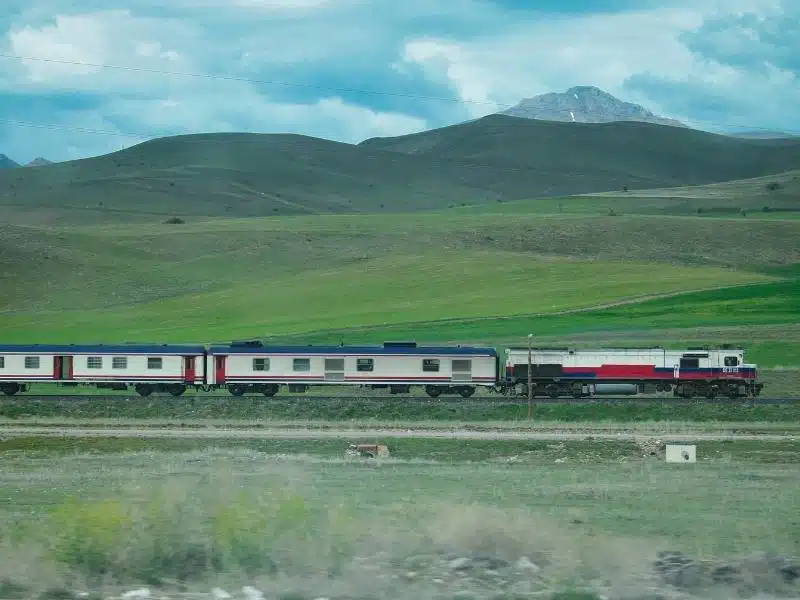
Where to Stay in Ani
There is no accommodation in Ani or the village of Ocakli, but you’ll find a few good options in Kars.
Budget
Konak Hotel 2
Mid Range
Kars Konak Hotel
Luxury
Hotel Katerina Sarayı
How Long Do I Need to Visit Ani Ruins?
We would suggest two to three hours should be enough to explore Ani, but if you’re a keen photographer, or want to scramble up to the citadel or explore the nearby caves, you may want to allow half a day.
Is this your first time visiting Turkey? Get all the information you need in our Turkey Travel Guide, including what to pack, the best time of year to go, getting there and practical tips to help you have the best trip!
When to Visit Ani
The medieval Armenian city of Ani can be visited year-round. It will be cold and possibly covered in snow in winter, which gives the whole place a beautiful ethereal ghost town feel.
The best times to visit are spring and fall when the weather will be kind. In spring, wildflowers carpet the site and in autumn, the residual summer heat and lower sun create wonderful light and atmosphere.
Avoid July and August if you can, it will be blisteringly hot and there is little shade. If you do visit in the height of summer, wear a hat, carry plenty of water and don’t forget the sun cream.
We would also advise against traveling to Ani during the holy month of Ramadan. It’s unlikely you’ll find any restaurants open in Ocakli or even Kars, and many hotels will also be closed.
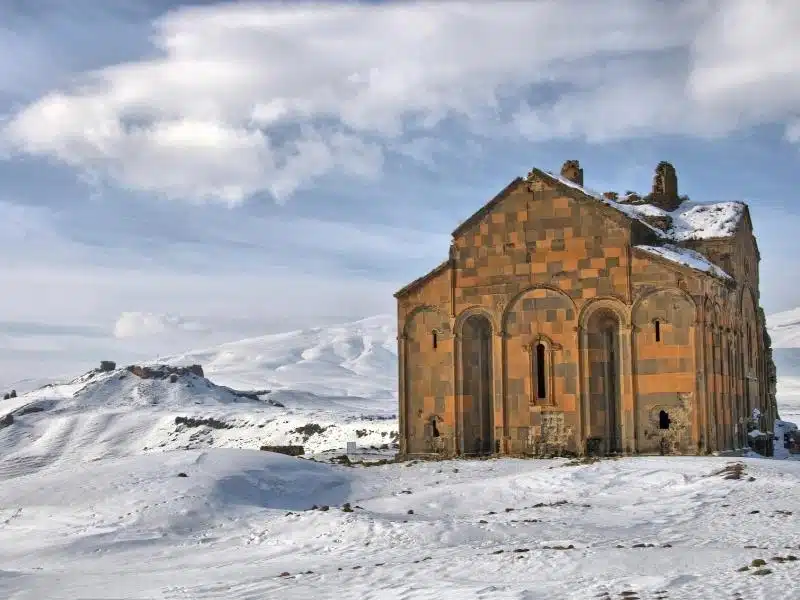
The History of Ani (in brief!)
Well-located and surrounded by natural defences, Ani was chosen by the Armenian Bagratid King Ashot III to be his new capital city in 961, and his successors nutured the city, which grew and prospered.
The Byzantines took over Ani in 1045, before the city fell to the Great Seljuks of Persia, the Kingdom of Georgia and local Kurdish emirs, in turn. In 1236 the Mongols arrived, expelled all who came before them and stayed until the great earthquake of 1319 destroyed most of the city.
The city began to decline and various rulers made bad decisions. The trade routes shifted and in 1336, the mostly Armenian citizens were forced to leave. So began the decline of a once great Silk Road trading hub, which was finally abandoned in the 17th century after bearing witness to 23 civilizations and dynasties during its reign.
In 1878 the Ottoman Empire’s Kars region, which included Ani, was incorporated into the Russian Empire’s Transcaucasian region. Turkey’s surrender at the end of World War I led to the restoration of Ani to Armenian control, but a resumed offensive against the Armenian Republic in 1920 resulted in Turkey’s recapture of Ani. In 1921 the signing of the Treaty of Kars formalized the incorporation of the territory containing Ani into the Republic of Turkiye.
RELATED POST: Things to Do in Armenia: Top Must-See Sights & Activities
What about staying connected in Turkey? In our detailed guide to SIM cards in Turkey, we share how to get a tourist SIM, the best eSIMs for Turkey and how to get a Turkey SIM card before you even get there!
Visiting the Ruins of Ani
The City Walls & Lion Gate
As befits a city of such importance, Ani’s volcanic basalt fortified walls are thick, sturdy and two-layered in some places. At one time these walls would have encircled the numerous churches, mosques, palaces and caravanserais of the city.
Now only a small part of the walls are visible, close to the entrance to the site. Just inside the walls is the Arslan Kapisi or Lion Gate, named after Alp Arslan, the Seljuk sultan who conquered Ani in 1064.
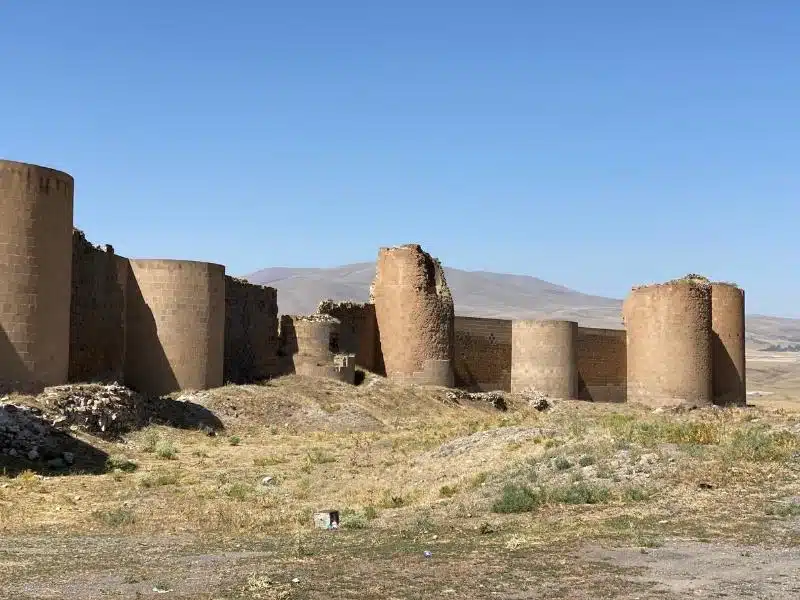
The Church of St. Gregory of Abumarents
As you walk under the great arch, your first view is of undulating hills covered in sun-scorched grass, dotted with great buildings silhouetted on the skyline, the most complete of which is the Church of St. Gregory of Abumarents.
This well-preserved round church with a conical roof dates from the late 10th century, and like much of Ani, was built using local volcanic basalt. The exterior is twelve-faced, with the interior featuring a six leave clover plan. I loved this church for it’s place on the horizon, and the views toward the citadel from the doorway.
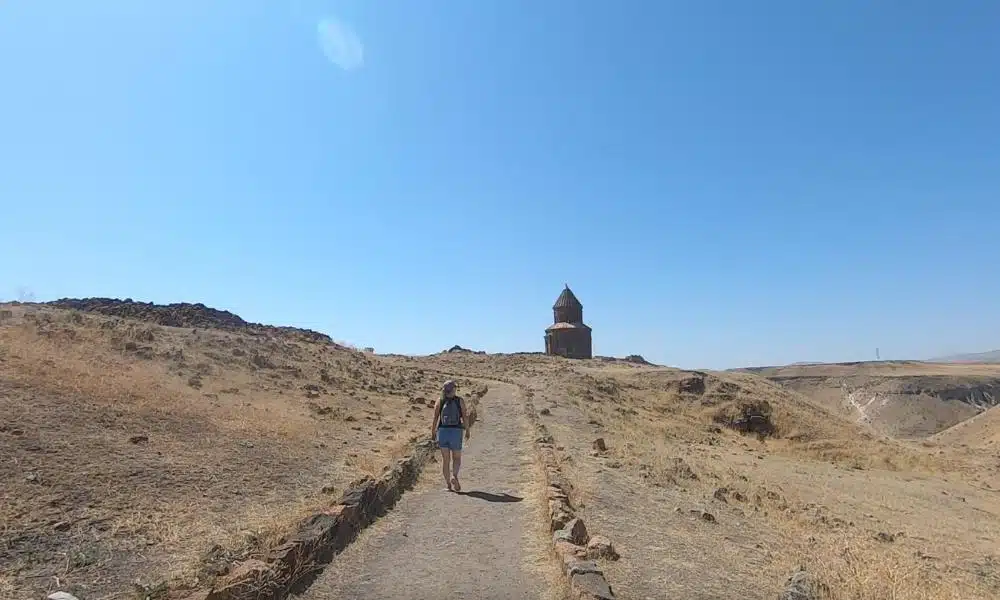
King Gacik’s Church of Saint Gregory
This once enormous circular church was commissioned by King Gagik and begun in 998. What must have been a magnificent, but structurally unsafe dome, collapsed shortly after it was finished. Over time, the knowledge of this once impressive building was lost and dwelling houses were built nearby using some of the fallen masonry.
In 1906 the ruins were excavated and the plan of the church revealed. Many objects of worship, including a bronze candlestick and a chandelier, were recovered.
All you can see now are a few outer columns and a jumble of outer walls and rocks, which give a good idea of the shape and scale of the building, but not the grandeur and elegance the plans suggest was evident in its design.
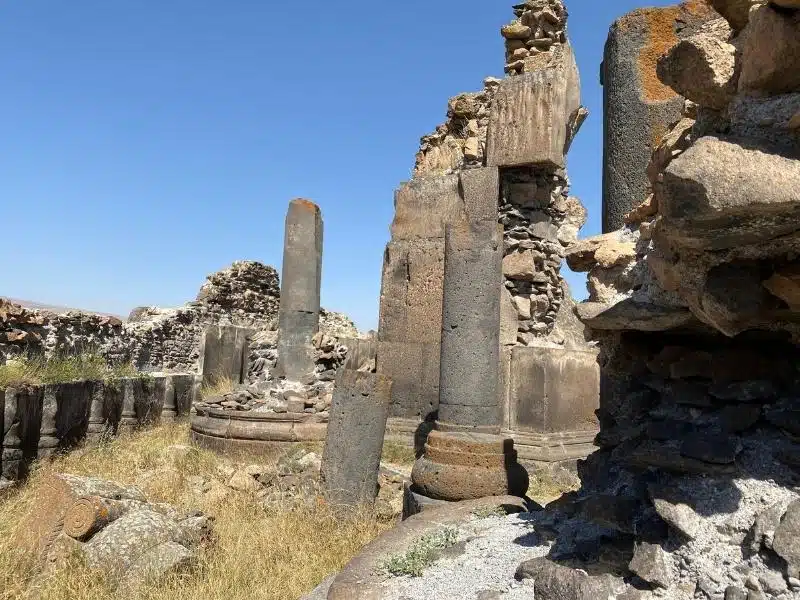
Make sure you have travel insurance you can trust when visiting Turkey. We recommend True Traveller for their 5 star TrustPilot reviews, variety of cover options, great prices and excellent service.
Zoroastrian Fire Temple
The foundations of this unusual building were excavated in 1909, and it’s thought the four squat columns of the fire temple are the oldest surviving structures on the site, proving the existence of at least one building in Ani which pre-dates the Christian period.
Zoroastrianism is an Iranian religion and one of the world’s oldest organized faiths, with a fire temple being their place of worship.
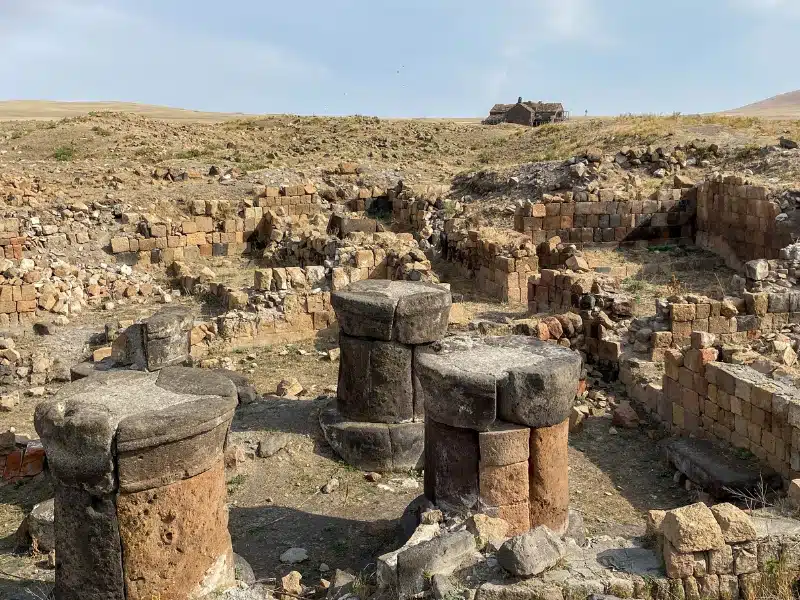
Karavansaray
The Church of the Holy Apostles dates back to 1031, but when the Seljuks conquered the city they made the church into a karavansaray, where merchants would stay the night as they traveled the Silk Road.
The building has suffered in recent years with a partial roof collapse and some unsympathetic excavation, but walking around the ruins, it’s easy to imagine how busy and bustling this place would have been when the Silk Road was in its heyday.
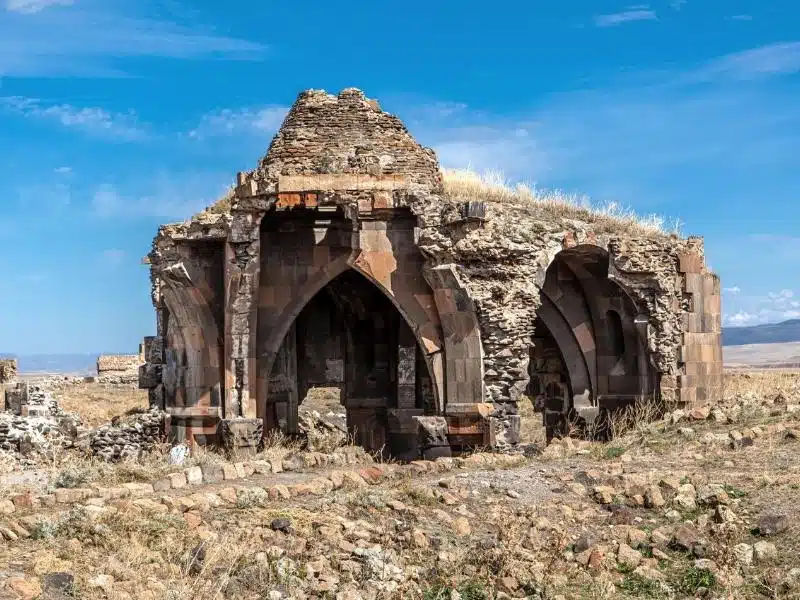
Ani Cathedral
Close to the southern edge of the city is the imposing Cathedral of Ani. The largest and most important building in Ani, the cathedral is of huge international architectural importance.
It is thought that building work started in 989 and was completed by 1001, or even 1010 depending on the reading of the inscription! The cathedral was the work of Trdat (he of the collapsing Gagik’s Church), who was one of medieval Armenia’s most respected architects.
Legend says that during the siege of Ani in 1064, the victorious Turks looted the city and pulled down the large cross atop the cathedral’s conical roof. It is said that this cross was sealed under the threshold of a mosque so that it could be continuously trampled upon.
After the siege, this bastion of Armenian architecture was converted into a mosque and renamed the Fethiye Camisi or Victory Mosque. The mosque was returned to Christian usage in 1124, and it is believed that restoration work was carried out in the 13th century. In 1319 a catastrophic earthquake brought down the dome and very probably marked the end of the building’s religious use.
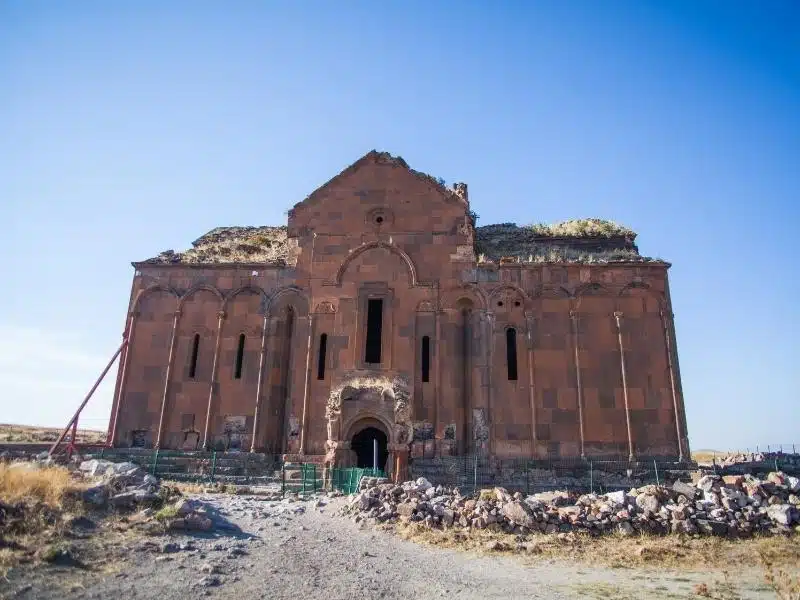
Ebul Manucehr Mosque
The Menuçehr Camii (mosque) was built at the very edge of the Arpacay gorge, the natural border between Turkey and Armenia. The mosque was founded by the emir Minuchihr, the first of the Shaddadid dynasty that ruled Ani from around the year 1072 onwards.
There is an ongoing debate about the actual construction date and origin of the mosque, which probably has more to do with the ongoing difficult relationship between Turkey and Armenia, fuelled by their previous differences and the widely internationally recognised (but not by Turkey) Armenian Genocide of 1915-16.
Armenians believe the building predates the Turkish conquest and that it was originally a palace or customs house from the Bagratid period, later converted into a mosque. Turks consider the structure to have been purpose-built as a mosque just after the Turkish conquest of Ani in the middle ages, which would make it the earliest surviving Turkish mosque in Anatolia.
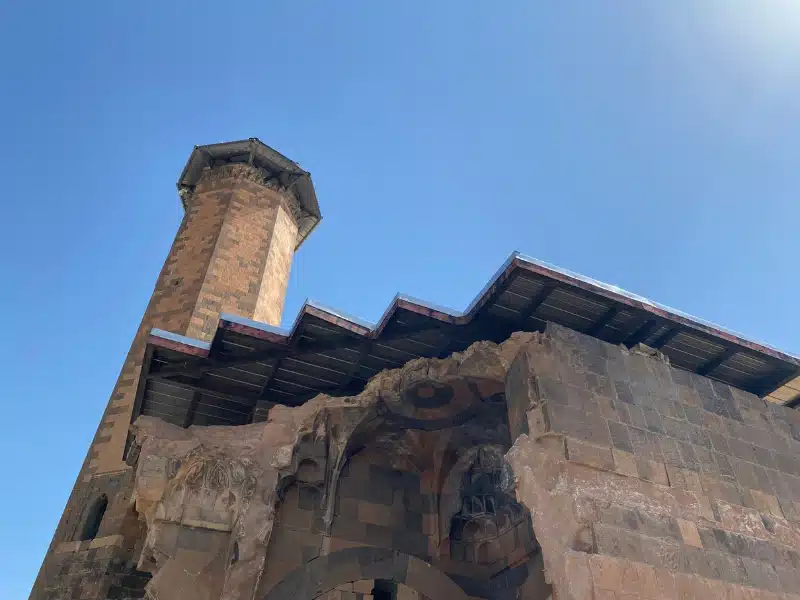
Silk Road River Bridge
From the mosque, you can look east along the gorge and see the ruins of the old bridge over the Arpa River, where goods would have arrived in the Armenian kingdom’s most prosperous city from Europe and the Middle East as they travelled the Silk Road. All that remains of this single-span bridge are the abutments on either side.
The grassy steppe of Armenia lies on the other side, so close yet so far. All that’s visible other side is a track through the grass that ends tantalisingly close to the ruined bridge, and a watch tower on the horizon.
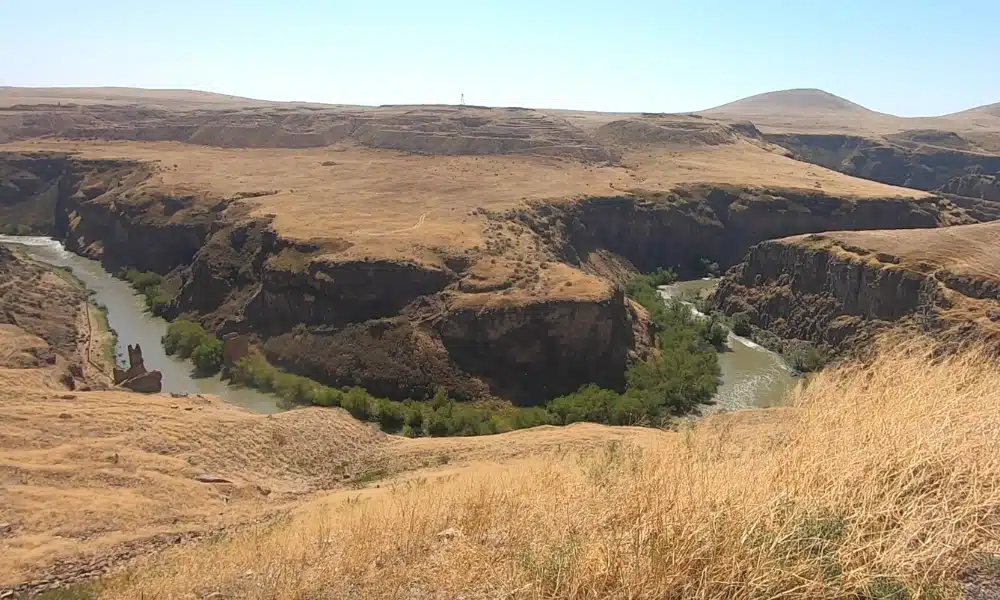
The Monastery of the Hripsimian Virgins
A little further east along the river and perched on a precarious cliff above is the Monastery of the Virgins, where it’s thought a community of nuns once lived. Sadly, under current Turkish restrictions, visitors to Ani are not allowed to visit the Virgin’s Monastery.
Within a walled enclosure are the remains of several buildings including a (reportedly) very beautiful chapel thought to date from the 13th century. It is now an extremely picturesque ruin perched on a pinnacle of rock above the river.

The Church of Tigran Honents
Properly called the Church of Saint Gregory of Tigran Honents has an inscription on the eastern wall which tells us that the church was commissioned by Tigran Honents in 1215, likely a wealthy merchant of the time.
At the time Tigran Honents was built, Ani was under Georgian control and it is believed that this church was devoted to the Georgian Orthodox Rite, with wonderful interior frescoes painted by Georgian artisans.
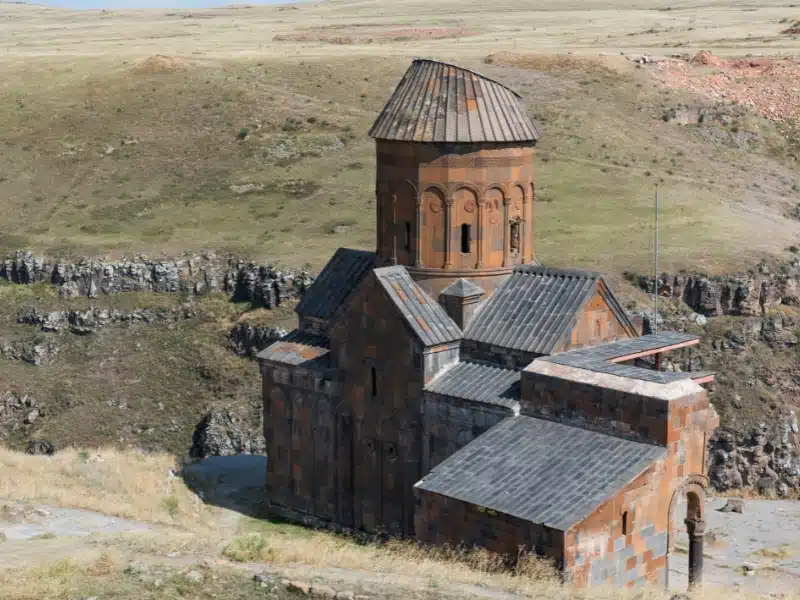
The Church of the Holy Redeemer
This large round church was commissioned by Prince Ablgharib Pahlavid around 1035, to house a fragment of the True Cross, which he obtained in Constantinople. The interior walls are covered with beautifully carved inscriptions that reveal much of its history.
By the end of the 19th century, the church was still standing but in an advanced state of dereliction. Some of the church was restored in 1912, but the eastern half collapsed in 1957, and the remainder was badly damaged during the 1988 earthquake and is now in danger of full collapse.
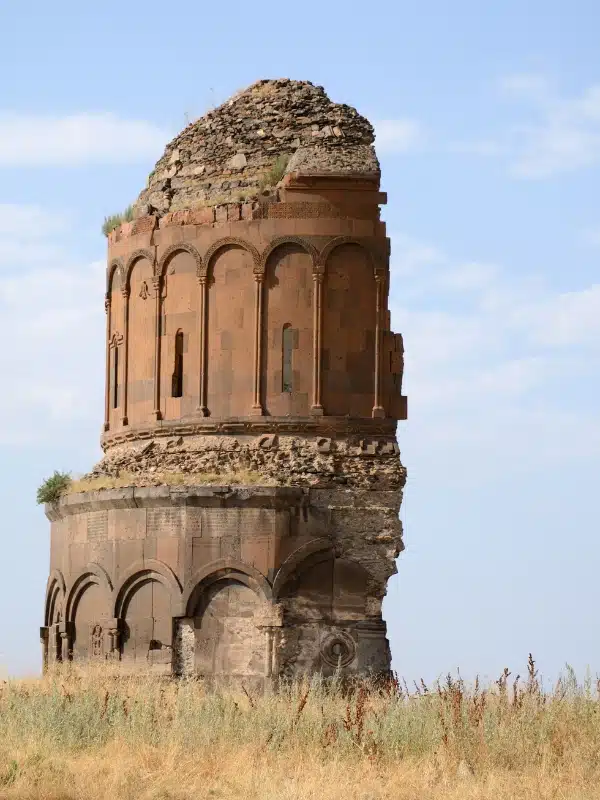
The Citadel of Ani
At the southern end of the city and occupying the most raised position for miles, Ani Citadel or Ic Kale rises from the grasslands to house a ruined palace and several churches within a single line of ramparts, which date back to the 7th century.
Much of what remains is a jumble of stone blocks and ruined walls, but the views are truly breathtaking and afford a real birds-eye view of the site. To the north, you can look across Ani to Ocakli village and beyond.
To the south is Armenia, and to the west, there are views of the Tsaghkotsadzor canyon, home to an underground cave village where hundreds of 5,000-year rock-cut chambers house churches and residential dwellings houses.
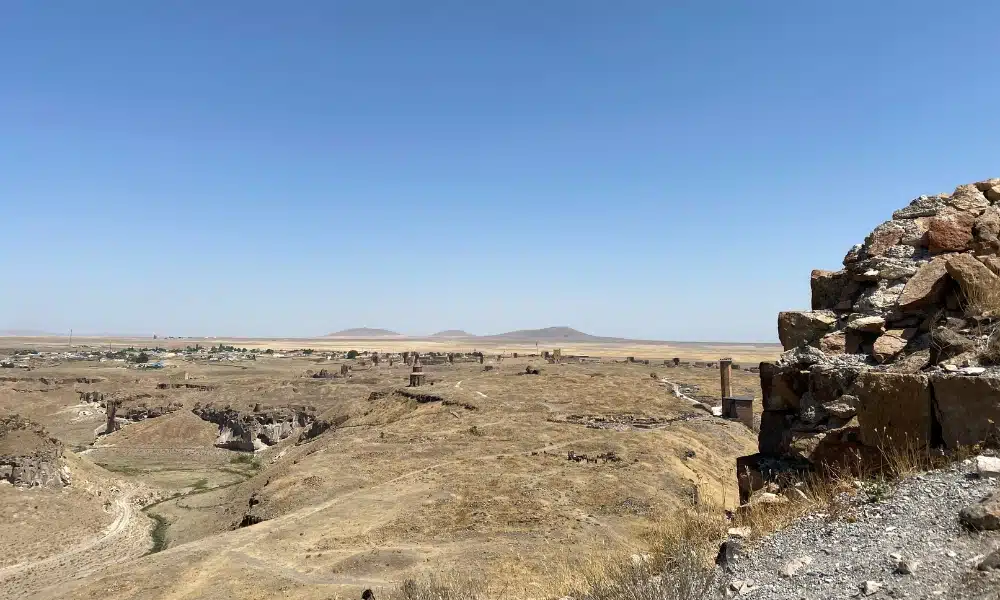
Maiden’s Castle
Past the citadel hill and right at Ani’s most southern point, the site narrows to a dramatic promontory that is almost encircled by a bow in the Arpa / Akhurian River and is protected by the near vertical cliffs of the gorge. The promontory is home to the unexcavated Maiden’s Castle or Kizkale, which tradition says was a pagan temple before Armenia’s conversion to Christianity.
Under current Turkish army restrictions, visitors to Ani cannot visit the Kizkale peninsula, which also lies outside the wire-mesh fence that surrounds most of Ani. You can get a good view of the castle from just outside the mosque, or from the citadel.
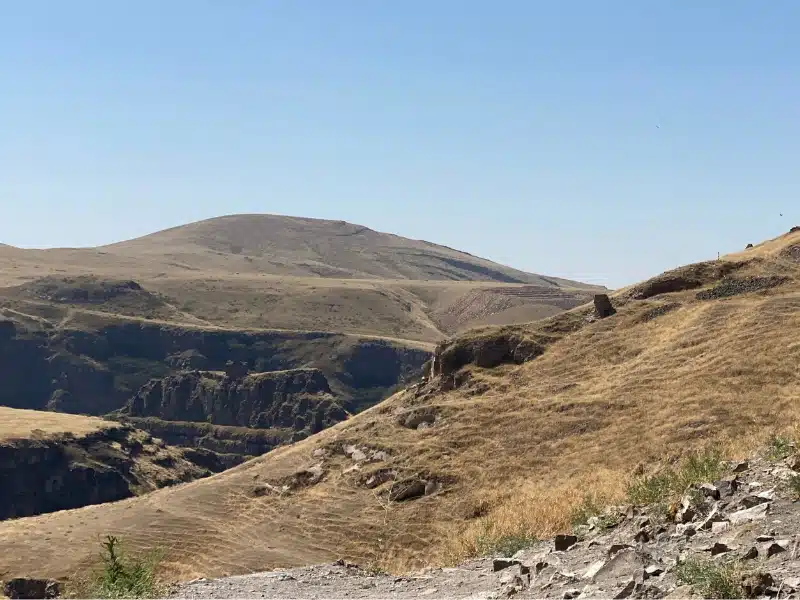
Are you planning a road trip in Turkey? Get the best Turkish road trip destinations and places to see/things to do en route + maps and nearby attractions so you don’t miss a thing!
Things to Do Near Ani
For all its remoteness, there are lots of interesting things to see in this area of eastern Turkey. There are also a number of other historical Armenian cultural heritage sites close to Ani, and the website Virtual Ani has a helpful list here.
It is possible to have a poke around the caves to the west of Ani, which can be accessed from the site or the local village. If you do decide to explore, wear sturdy shoes and make sure to take water and carry a working mobile phone.
Kars
Multi-cultural Kars has an eclectic mix of influences – Kurdish, Azeri, Turkmen, Russian and of course, Turkish. It’s a popular base for visiting Ani but is worth a visit in its own right.
Wander the city, especially around the older part of town, to enjoy the pastel-painted belle epoque architecture and cafes which line the streets. Kars Castle and Kars Museum offer interesting insights into the history of Kars, and the castle also enjoys spectacular views.
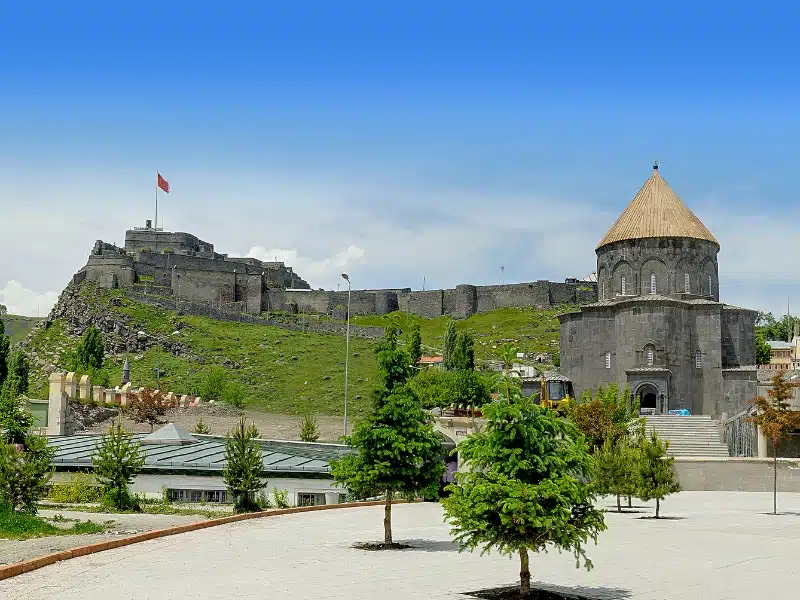
Dogubayazit
A three-hour drive south of Kars is the Kurdish city of Dogubayazit, perfect for hiking the mighty Mount Ararat and visiting the splendid Ishak Pasa Palace.
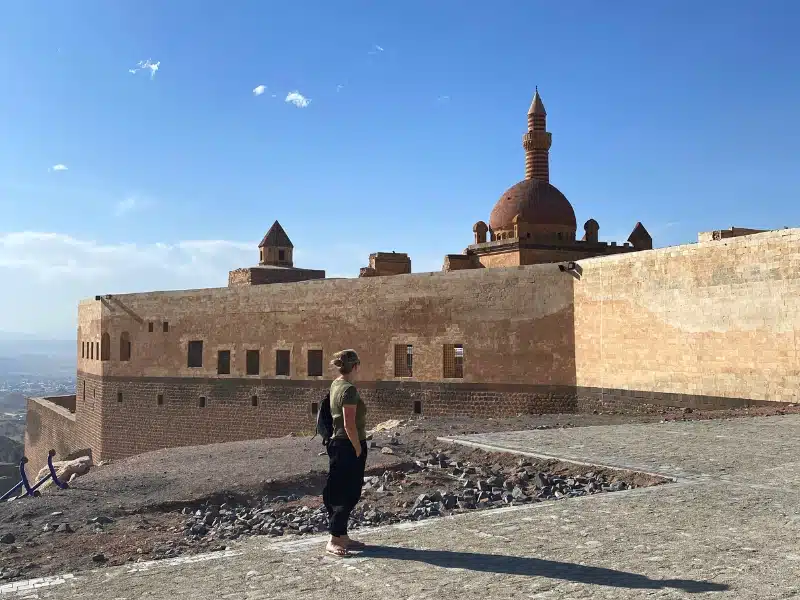
Georgia & Armenia
The border with Georgia at Khozapini-Kartsakhi Lake is just a few hours drive from Ani, and from there it’s a further hour and a half to the Armenian border at Bavra (it’s not possible to cross directly from Turkey to Armenia).
This opens up a whole new set of attractions to visit, such as the fascinating cave city at Vardzia, which is just over the Georgian border, or the beautiful Lake Arpi National Park in Armenia, home to bears and eagles.
Looking for more travel inspiration? Check out these top posts…
Mount Nemrut Turkey: How to Explore the Mystical Mountain
Road Trip Georgia: 6 Amazing Routes
Europe Road Trip: 25 Incredible Routes
Adventurous Road Trip – 26 of The World’s Most Exciting Routes
Road Trip in Turkey: 20 Incredible Places to Visit
Planning Your Turkey Motorhome Adventure
Love it? Pin it!
